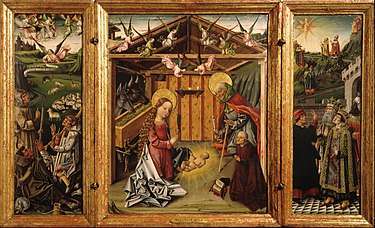Master of Ávila
The Master of Ávila, a painter in the Flemish style of Fernando Gallego, was active in Ávila and surroundings in the middle of the 15th century. The art historian Elías Tormo and others have tentatively identified him as García del Barco, a painter who was known to have been in Ávila between 1465 and 1473. No works by Barco have been attributed with any certainty.

Works
His artistic "personality" is based on a triptych of the Nativity, originally at the Convent of the Conception; currently at the Lázaro Galdiano Museum. It shows some resemblance to the panels of an altarpiece at the Iglesia Mayor de la Asunción de Nuestra Señora in El Barco de Ávila, which also corresponds to some of the stylistic elements in the works of the Master of La Sisla, who may have been his apprentice.
Other works that have been ascribed to him include the Abrazo ante la Puerta Dorada (Embrace Before the Golden Gate) at the Church of San Vicente de Ávila, a triptych of Saint Dominic and Saint Thomas at the Museum of Vitoria, and altarpieces at the Churches of Saint Martin in Bonilla de la Sierra and Saint Peter at the Cathedral of Ávila. Recently, a "Calvary" at the Museo del Prado, originally assigned to Fernando Gallego, has been re-attributed to him.[1][2]
García del Barco
García del Barco was known to be active as a painter in Ávila during the 1460s, when he sold a horse to a local clergyman.[3]. He appears as a "famous painter" in 1473, when he was hired by Gallego to work on an altarpiece at Coria Cathedral and was delegated to act as one of his arbitrators in the event of any litigation. The other arbitrator named was one Father Pedro de Salamanca, who has also been proposed as a candidate for being the Master.[2] In 1476, he and another painter named Juan Rodríguez undertook to paint the doors and ceilings of the Castillo de El Barco de Ávila with Moorish designs; documented by Juan Agustín Ceán Bermúdez in his Diccionario histórico de los más ilustres profesores de las Bellas Artes en España.
At an undetermined date, after 1492, he went to Granada, where he died sometime after 1498.[3]
References
- Image in the Online Gallery, Museo del Prado.
-
- Cruz Valdovinos, José Manuel, "Sobre el maestro de Ávila (pinturas inéditas de Juan Rodríguez fechadas en 1479)", in; Anales de la Historia del Arte, nº 4, Homenaje al Prof. Dr. D. José Mª de Azcárate, Ed. Complutense, Madrid, 1994, pp. 559–567.
-
- Ruiz Ayúcar, María Jesús, "Breve historia de San Miguel de Arévalo y la pintura hispanoflamenca en Ávila", in; El retablo de la iglesia de San Miguel de Arévalo y su restauración, Institución Gran Duque de Alba, Ávila, 1985
Further reading
- Díaz Padrón, Matías, and Torné, Angelina, "La Crucifixión atribuida a Fernando Gallego del Museo del Prado, restituida al Maestro de Ávila", in; Boletín del Museo del Prado, vol. XIX, Madrid, 1996, pp. 75–80.
External links
| Wikimedia Commons has media related to Master of Ávila. |
- Biography in the Online Encyclopedia @ the Museo del Prado